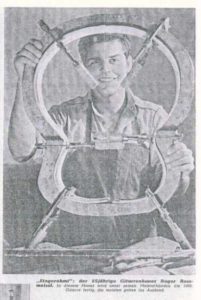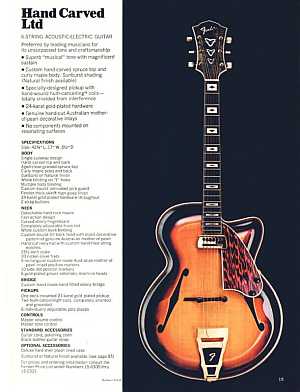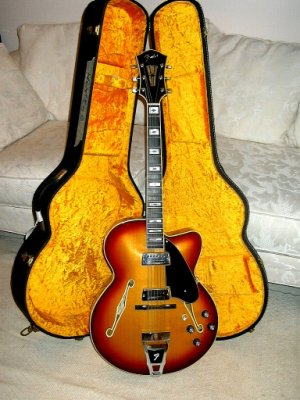
Roger Rossmeisl at 25
Over time I learned more about Roger’s childhood in Germany. Roger was from Berlin. His father was a guitar maker and as I recall worked for “Eko,” an Italian firm. When Roger was about 8 years old World War II was going on. Roger told me once that he remembered one day his mother told him that he couldn’t play with his Jewish friends anymore. The reality of the war was sinking in as Roger saw them disappear. He recalled the Russian tanks running through town. He saw some despicable sights that made life tough for young Roger. These memories caused Roger to have trouble sleeping because of nightmares. The situation became so unbearable that Roger’s parents sent him to school in Bubenreuth at about 8 years of age. The location in the southern Alps must have been beautiful and distant from the madness of the war. Eventually, the war also had its effect in Bubenreuth. The amenities of life became scarce, there was no fuel, no tires on vehicles, as life became very serious in contemplation of an unpredictable future. The school carried on, providing all required subjects, math, reading, language, writing, science and education with a major in instrument building. Roger had to get up before everyone else and start the fire in the stove to heat the workroom. Roger’s guitarmaking teacher was a famous lutemaker named Franz Hirsch. Herr Hirsch taught in an old world tradition of apprenticeship. He was responsible for turning out “masters” so he expected a great deal from his students. Guitarmaking studies were largely around classical and archtop jazz types with an emphasis on theory and craftsmanship. Roger was one of the youngest graduates from that school, a course of 8 years. At graduation he was presented his Masters diploma and was pronounced a “gitarrenbaumeister.” The degree also gave Roger teaching credentials in guitar making. Roger got to know some people that went on to their own fame as guitar makers. Klira, the designer of the “Beatle bass” and “Hauser,” known for classical guitars also attended. Roger loved jazz and we always had jazz on the radio at work. After graduating from Bubenreuth Roger started building jazz guitars back in his beloved Berlin, becoming part of the post-war jazz scene. Berlin was a center for jazz and attracted many American artists. Roger’s archtops had tailpieces with a stylized “R” on the tailpiece. I’ve never seen one, just a photograph Roger showed me many years ago. The arch top carving was like that of Roger’s “LTD” Fender design.
At some point Roger emigrated to America to work for Gibson. I wish I knew more about these years. Then Roger was hired by Rickenbacker to design guitars. And then, Roger was hired by Leo Fender to design a line of acoustics. The King, later changed to Kingman because of a trademark conflict, and the Concert were the beginning of Fender acoustic guitars.
The LTD was introduced as Fender’s entry into the archtop jazz guitar market. The LTD in particular was to be a prestigious example of Fender’s ability to produce a highly crafted, handmade unique jazz guitar to stand up to the long established archtops of the day, particularly the Gibson Citation. The LTD was the most costly to make and most expensive guitar Fender was making at the time.
Roger Rossmeisl began his career at Fender by designing the acoustic “King” and “Concert” guitars in 1962. When production of acoustics was transferred to Babe Simoni, Roger became the head of R&D for acoustic guitars. His job was to design a jazz guitar line with several models to fill the market needs. I lost touch with Roger for several years during this period. I continued on in the acoustic guitar division as a production worker. After the CBS purchase of Fender in 1965, a huge new building was erected adjacent to the original 9 Fender buildings. The entire Missile Way production facility was moved to the new main plant.
The employee entrance to the main plant was at the back end of the building. As you came in one of the two sets of glass doors, there was a spacious lobby with the personnel offices to one side and several security people guarding the entrance. One morning, in the entrance lobby, there was a large glass case on a pedestal with Roger’s first carved archtop sunburst jazz guitar inside. It was beautiful with all gold-plated parts. The reason it was there was that the guitar did not have a name yet. The idea was to ask any employee that had a suggestion for a name to submit it. It was a contest, but I do not recall if there was a prize. Although I could have submitted as many names as I wanted, I only submitted one and it was “Carousel.” The name that was chosen was “LTD.”
Soon after that, I got a call from Roger. He knew that I was going to college at night, majoring in Metallurgy and wanted to ask me some questions about “aging,” a metallurgical term. I didn’t understand why he would call me with such a question, so it seemed kind of odd. I think he was just making contact with me because shortly afterward he asked me to come by for a visit. He had just finished designing the LTD and Montego and wanted me to be his assistant in the department. Roger hired me originally as a production worker in his acoustic division 5 years earlier. This opportunity was a second new beginning for my career. A few days later I had my own parking place next to all the R&D staff. This was about 1968.
The department was housed in “Building 3,” in one of the 13 original Fender buildings. Roger had set up a nice woodworking facility with all the machines necessary for manufacturing the “LTD.” There were 2 large imported German workbenches with 5” thick solid maple tops with huge built-in vises specially made for violin, cello and guitar making, etc. Fender still has those workbenches. We had a buffer, edge sander, shaper, jointer, spraybooth, bandsaw, tablesaw and a whole host of hand tools. There was also a North Star carving machine for carving tops and backs for “LTD’s.” The R&D Department was titled “Acoustic Guitar Research and Development.” The department actually did much more than that and in fact was used for the majority of any prototype that required woodworking. The main focus was the “LTD” and “Montego” production but we always seemed to have a special project going on the side. Roger was just finishing up a project called the Zebra guitar and bass. The Beatles and Stones were major forces musically, and two groups began to form in London around two styles of music, known as the “Mods” and “Rockers.” These were the names given to the Zebra guitar and bass. The guitars were never produced, only prototyped by Roger Rossmeisl. The photograph of Roger talking to Wes Montgomery in front of Roger’s workbench in R&D shows a Zebra guitar prototype. The body was solid zebrawood carved in a fashion used in the “LTD” jazz guitar. Wes and his brother, Monk Montgomery, a bass player in Las Vegas, were friends of Roger’s that used to visit occasionally.
The situation as I arrived was that Roger had designed the Montego and LTD and was in the early stages of production. He was having the Montego bodies made in Germany. They came in completely glued up with binding installed. They were very nicely made with European woods, both spruce and flamed maple being whiter than American varieties. Montego bodies had arch tops of selected laminated spruce. The backs and rims were white European flamed maple. The bodies were unfinished and all the painting was done right there in R&D.


The Montego
The “LTD” was also designed and prototyped. The LTD was a carved arch top jazz guitar with the same rim shape as the Montego. The arch top and back carving style was uniquely Roger’s. The arch shape took place in an area 2” from the edge of the rim. From the binding the top dipped down .150”, then curved up .350” all within 2” from the rim. The raised portion of the top was flat. “F” holes were machined in but not bound to show that the top was solid spruce. The back was carved in a similar manner. The tops and backs were carved on a single station “North Star” carving machine. This is a typical way for rough carving arch top guitars. The machine has two stations, one for holding the work and one for holding a pattern. The operator controls a hand-held stylus arm which is moved around the pattern. A motorized cutter mounted to another arm is connected by linkage to the stylus arm. As the stylus arm is moved the cutter arm responds in exactly the same manner. So, a pattern of the top of the guitar would be installed on the stylus side and the wood block for the top appropriately beside it. The operator holds the stylus with two hands, guiding it over the pattern and the cutter responds, carving the top exactly like the pattern. This type of machine is manufactured with multiple stations as was used by the Banjo Department to carve necks. My problem was that we had no carving patterns. Roger made the prototype by hand. Making the patterns was a particularly challenging project because of the tolerances and the pattern had an inside and an outside carve. There was also one made for the back.
We would make a batch of about 6 at a time. The tops would be carved then sanded. The “F” holes would be routed, then two independent spruce braces would be glued in and shaped. The top would be glued to the rim. The rims were exactly like the Montego and were imported as rims for the LTD. The backs would be carved, sanded and glued to the rim. Just before glueing, Roger would sign and date the label for the inside of the back. The binding was 5 separate strips, all installed at the same time. Roger always seemed to enjoy doing the binding and did a great deal of it. After binding, preparation of the bodies for painting took place. This was a long, slow perfecting process, feathering the contours to perfection. Then the neck slot would be routed in and the body was ready for paint. Roger developed a blended transparent color that would be sunbursted on after the sealing coat. Then the center portion would be shot with yellow and then a thin coat of clear. All the color would be scraped from the binding then topclear coats applied with sanding in between. The clear was a synthetic varnish that was fabulous. Then after drying, sanding and buffing would finish the body off.
We also made the necks for the LTD and Montego. The necks were similar except for the headface cap and an inlay strip in the fingerboard of the LTD. Both headface caps were made in Germany. The LTD cap had a Mother of Pearl “Fender” and three mirror image F’s as a design. The Montego had a design, Roger told me, that was inspired by the marquis at the Tropicana Hotel in Las Vegas. The LTD fingerboard had white binding along the edge and a black-white-black inlay in the fingerboard just inside the edge. The Montego only had white binding on the edges. The necks were flamed or blister maple with a center strip of Padauk, Indian rosewood or East Indian rosewood. Roger used a double truss rod in both necks. Scale length was 25.5” with a medium fret. Mother of Pearl position markers were inlaid into the fingerboard.
There were several designs of pickups developed by Freddie Tavares. He was a good friend to me and everyone that knew him. The pickup was a specially developed humbucker with a jazz sound. It was attached to the end of the neck and suspended above the top. A beautiful flame patterned celluloid pickguard material that Roger got from Italy was made into pickguards then bound with a multi-layered black and white binding. The circuitry was one tone and one volume control as well as a miniature jack all in a small brass frame mounted to the pickguard.
We only produced 36 “LTD” jazz guitars. Natural finish was offered in the catalog but there was never one made. They are all sunburst. I saw all 36 but haven’t seen one since I left Fender. I signed a few inside the top, so, the only way to see my name is with a mirror.
Roger left the company in 1971 and moved back to Germany. Roger had rented his own private industrial space where he set up his own workspace and getaway. This was where he kept much of his personal property. He took as much as he could then sold and gave me the rest. The jazz guitar department was closed after I finished up the last guitars. I was issued one last project at the request of Gene Fields in R&D. The project was the first Starcaster guitar. That’s another story.